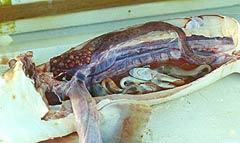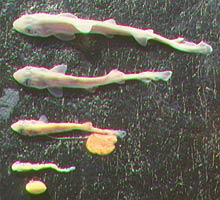Sensory Systems
Chondrichthyans have at least eight well-developed sensory systems.
- The paired eyes provide an excellent field of vision, are able to see colour and are good in low light.
- An excellent sense of smell is provided by the two olfactory sacs under the snout, which are associated with the large front section of the brain.
- Taste-receptor cells occur on taste buds, which cover small bumps in the mouth and determine whether prey tastes good.
- Touch-receptor cells occurring near the skins surface respond to contact and smaller capsules deeper in the skin respond to the bending of the body and fins through muscle movement.
- Senses of balance, orientation and movement depend on a complex system of organs inside the ear.
- Sound is channelled through a series of cartilaginous tubes to the ear canals, and hearing is very good even though sharks and rays lack external ear structures.
- Clusters of sensory hair cells detect water movement or vibrations. These are situated both on the surface of the skin (pit organs) and also just below the surface of the skin (lateral lines), which run across each side of the head and body.
- Electrosense is present in all sharks and rays, but is uncommon among other groups in the animal kingdom. The electrosensory organs (Ampullae of Lorenzini) are able to detect weak electric fields generated by the movement of prey, predators and water in the Earth’s magnetic fields.
Reproduction

School shark
(Galeorhinus galeus) in utero
(© Terence I. Walker) |
Sharks and rays have separate sexes for reproduction. They can be either egg laying or live bearing, and there are four different modes of reproduction for live-bearing conditions, depending on the source of nutrition for the developing embryo (yolk, uterine milk, other eggs/siblings or placenta).
The number of eggs laid or number of young born varies widely with species and size of the mother. The gestation period can vary from several months to well over one year. |

Developmental stages of the gummy shark (Mustelus antarcticus) – egg to juvenile
(© Terence I. Walker) |
Kate Sputore (Rottnest Island Authority) adapted this information sheet (which is suitable for primary school students) from the information sheet compiled for the general public by © Terence Walker (Terry.Walker@dpi.vic.gov.au).
This information sheet may be copied for educational purposes. For any other purpose please contact your State MESA representative: http://www.mesa.edu.au/council/contacts.asp |
|
